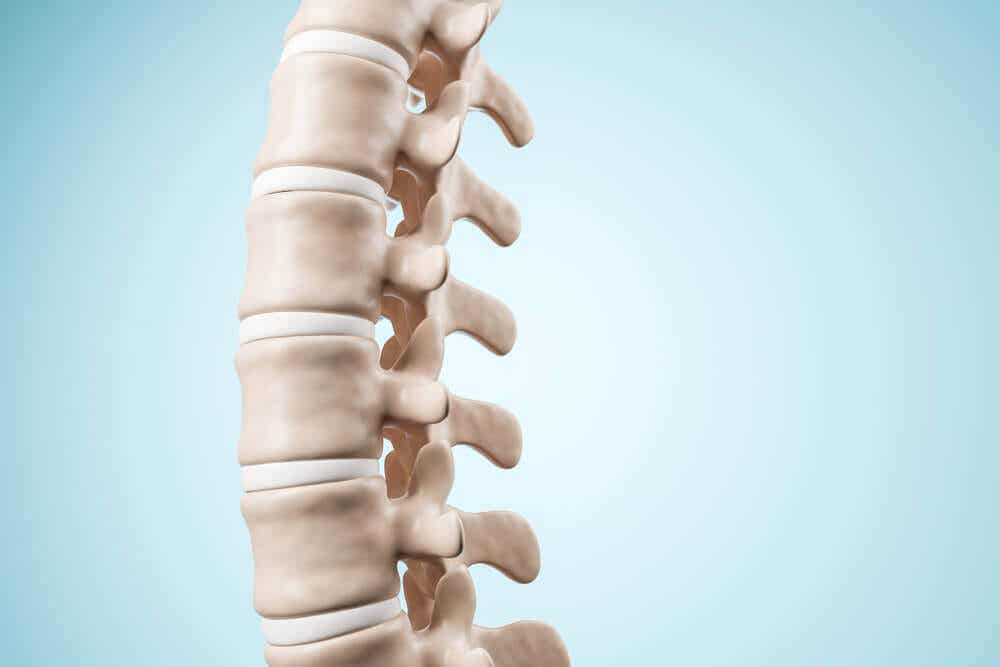Laminectomy Surgery: What is It and What are Its Risks?


Written and verified by the doctor Leonardo Biolatto
Laminectomy surgery is also called “open decompression.” It consists of removing the back part of a vertebra (called the lamina) to create more space in the spinal canal.
The spine is made up of 33 vertebrae, separated from each other by the intervertebral discs. These are cartilaginous discs that cushion the collision between these bones. Doctors perform laminectomies to relieve excessive pressure in the canal that could damage the nerves or spinal cord.
It’s a procedure doctors use for patients with spinal arthritis. Although it’s usually a safe technique, there are risks and important things to consider. In this article, we’ll explain everything you need to know about laminectomy and how doctors perform it.
What does a laminectomy consist of?
Laminectomy surgery, as we’ve just mentioned, is a surgical technique performed on the spine. It consists of removing a portion of one or more vertebrae. The portion that is removed is called the lamina.
It’s also called open decompression because it relieves pressure on the spinal nerves and spinal cord. In most cases, it’s performed when other treatments, such as physical therapy or medication, have been insufficient.
The increased pressure may be due to health issues such as osteoarthritis, herniated discs, or tumors. The idea is that when the nerves are compressed, pain, mobility alterations, and even loss of sphincter control usually appear.
Professionals perform the relief procedure through a cut in the back. Through the incision, doctors remove part of the vertebra or vertebrae that are causing the condition. Once this is done, they remove the herniated part of the disc.
The nerves and muscles return to their original position and the doctors close the cut. This way, the space in the spinal canal is increased. If the lesion affects the neck, doctors usually perform the approach anteriorly.
In some cases, specialists combine the technique with others, such as arthrodesis, so that the spine doesn’t lose stability. Arthrodesis consists of fusing two vertebrae together, preventing them from slipping.

Why do people get it?
Specialists perform laminectomy surgeries to relieve excess pressure within the spinal canal. Doctors often associate this pressure increase with bony overgrowth of the vertebrae. It occurs, for example, in cases of arthritis and osteoarthritis.
The problem is that the pressure causes damage to the spinal cord and spinal nerves. These patients often suffer a lot of pain, the location of which varies depending on which area it affects. In addition, there may be weakness, numbness, and loss of sphincter control.
Laminectomy surgery is usually reserved for cases where less aggressive treatments have failed. For example, when analgesic drugs don’t relieve pain or physical therapy doesn’t improve other symptoms.
It’s also usually indicated when the severity is very noticeable when it affects the patient’s daily activities. If the patient is unable to control sphincters, walk or stand, doctors perform a laminectomy surgery.
According to Mayo Clinic specialists, it’s a technique that doctors can use to treat herniated discs, especially those in which it isn’t possible to access the damaged disc. Lumbar stenosis is another of the main reasons for its prescription.
Also read: What are the Causes of Lumbago (Lower Back Pain)?
What are the risks of laminectomy surgery?
Laminectomy surgery is a safe technique. However, we must keep in mind that the spine is a complex and delicate structure. In addition, like any other surgery, doctors associate it with several possible complications.
For example, there may be bleeding, blood clots, or wound infection. During this intervention, the spinal nerves may receive some damage. This could leave after-effects such as weakness, numbness, or even paralysis.
There may also be leakage of cerebrospinal fluid or tears in the fibrous tissue that covers and protects the spinal cord. These complications require, in most cases, a second surgery.
How to prepare for a laminectomy
Before the patient gets a laminectomy surgery, the patient must know all aspects of the procedure. Most likely, doctors will suspendor modify certain treatments beforehand.
In addition, on the day of the procedure, they must avoid eating or drinking liquids in the hours before the procedure. Doctors recommend that patients receive help the days following the procedure, as activities such as cooking or even toileting may be difficult.
Keep reading: What is Abdominoplasty, or Abdominal Wall Surgery?
What happens during a laminectomy
As an article from WebMD Corporation explains, doctors perform laminectomy surgeries under general anesthesia. Therefore, specialists must intubate the patient during the procedure. They usually perform this operation through a cut in the back, unless they must treat the cervical spine.
Through the incision, doctors dissect the tissues to reach the affected vertebrae. The surgeon will remove the lamina or bone spurs that are compressing the nerves. In some cases, they may have to remove several different bones.
Similarly, as mentioned at the beginning, laminectomy may be combined with other techniques. For example, with an arthrodesis to stabilize the spine. If there’s a herniated disc, the specialists will likely remove the affected disc (the technique is called discectomy).
After surgery
Laminectomy is a procedure of variable duration. Although in some cases the patient can go home the same day of the intervention, most often the patient remains hospitalized for at least a few days. This way, they can observe if any complication appears.
Immediately after the operation, they transfer the patient to a recovery room. There, they examine if the sensitivity and mobility are adequate. Pain in the operated area is normal.
In addition, recovery is progressive. It usually takes a week to return to daily activities. Even in the first days, it can be complex to walk, lift things, or move. Usually, doctors recommend physiotherapy after the laminectomy.

Expectations for the procedure
Doctors consider laminectomies a safe procedure. In most cases, it significantly reduces the pain before the intervention.
When recovery is complete (about 2 to 3 months), patients who have undergone the procedure show great improvement. However, some symptoms may reappear over the years, especially if the underlying health problem progresses.
In some cases, patients may need a second operation. This sometimes happens because stenosis reappears in another part of the spine or the spine is unstable.
Laminectomy surgery is a complex procedure
It’s true that in most cases laminectomy surgeries produce a very significant improvement in symptoms. However, doctors usually reserve this treatment for people in whom other less aggressive treatments have failed.
The main reason is that, although it’s a safe technique, it still has risks. Therefore, a physician should always be the one who suggests the most suitable approach for each patient, depending on their health conditions.
All cited sources were thoroughly reviewed by our team to ensure their quality, reliability, currency, and validity. The bibliography of this article was considered reliable and of academic or scientific accuracy.
- Laminectomía – Mayo Clinic. (n.d.). Retrieved March 15, 2021, from https://www.mayoclinic.org/es-es/tests-procedures/laminectomy/about/pac-20394533
- Valles Quintana, Segundo Octavio. “Tratamiento fisioterapéutico en laminectomía lumbar.” (2019).
- Laminectomía para la estenosis espinal lumbar: propósito, procedimiento, recuperación. (n.d.). Retrieved March 15, 2021, from https://www.webmd.com/back-pain/guide/laminectomy-surgery-before-during-and-after
- Morejón Guerrero, Juan Bernardo. Paraparesia como consecuencia de laminectomìa en la vertebra l4. BS thesis. Universidad Técnica de Ambato-Facultad de Ciencias de la Salud-Carrera de Terapia Fisica, 2017.
This text is provided for informational purposes only and does not replace consultation with a professional. If in doubt, consult your specialist.








